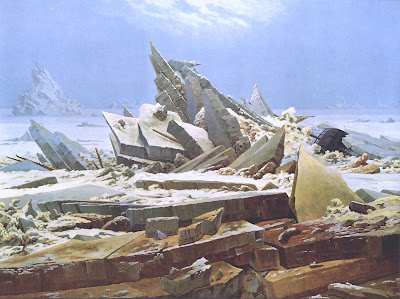 Thomsen River, Banks Island
Thomsen River, Banks IslandOne evening while I was at work in Seattle, the light outside was striking, so I took a break and went up to the roof to look out over the city. It was a clear day, and I could see some mountains in the distance – Mt. Baker to the North and the Olympics to the West. What a beautiful place! I look to these landscapes with a desire to be in them. Living here, they are a constant reminder of the wilderness that looms beyond human drama.
To some people these mountain vistas are simply images on the horizon, rendered two-dimensional by the distortion of distance. While others, through direct experience, have a richer sensory appreciation. The view additionally stimulates their tactile, aural and olfactory imagination, engendering a deeper feeling of actually being there. This enlivened experience of the land comes as a certain liability for people trying to document a place they have never been because it biases their observations towards more familiar places.
The farthest north I have been is the Yukon Territories, Canada, above the 60th parallel. I have never seen the Arctic Tundra, where there are few trees and extreme seasons. My imagination can only extrapolate to places I know. Hence, all filming will be preceded by extensive fresh observation utilizing all senses. This brings a certain sense of humility in approaching the topic. Hopefully the freshness will be an asset:
“A man in Anaktuvik Pass, in response to a question about what he did when he visited a new place, said to me, “I listen.” That’s all. I listen, he meant, to what the land is saying. I walk around in it and strain my senses in appreciation of it for a long time before I, myself, ever speak a word. Entered in such a respectful manner, he believed, the land would open to him … The physical landscape is an unstructured abode of space and time and is not entirely fathomable; but this does not necessarily put us at a disadvantage in seeking to know it. Believing them to be fundamentally mysterious in their form and color, in the varieties of life inherent in them, in the tactile qualities of their soils, the sound of the violent fall of rain upon them, the smell of their buds – believing landscapes to be mysterious aggregations, it becomes easier to approach them.”
-
Arctic Dreams by Barry Lopez
One location I am interested in is Banks Island. For the film, approaching a single island frees me from the overwhelmingly broad focus of “The Far Northern Landscape,” while achieving the same thematic goals through representation rather than inclusion. Banks is very large, with diverse Arctic landscapes – polar desserts and fertile river valleys. There is a small Inuvialuit town at the Southwest, a National Park at the Northeast and two Migratory Bird Sanctuaries East and North. I can only dream of spending time in these places with a video camera and audio recorder, weaving a story of the land that starts with my senses of touch and smell.

Banks is located in Northwest Territories, Canada, as part of the Canadian Archipelago, a group of islands formed by tectonic activity, not glaciers. It is 236 miles long and 180 miles wide, amongst the largest islands in the world. The features of the land include flat barren expanses, rolling hills, and river valleys, such as the Thomsen River in the Northeast. From mid-November until late January, Banks is shrouded by darkness, and from early May until early August it is illuminated by constant sun. In the Summer, the temperatures are in the 30s and 40s F and in the Winter they are in the negative 20s F. It is extremely dry, a polar desert, with an average monthly precipitation of 0.4 inches.
There are no trees on the island. The growing season is too short. The tallest plant, the willow bush, generally grows no taller than 4 inches. Three fourths of the world's Muskoxen live on the island. Peary and Barren-ground Caribou, and Polar Bears are also among the larger wildlife. There are many birds, including two thirds of the world’s population of lesser snow geese, which migrates through the farmlands of the Midwest during the approaching winter. The first Grizzly-Polar Bear hybrid was found on Banks Island in 2006.

Banks is home to 114 people. That is 1 person for every 237 square miles. These permanent residents live in the town of Sachs Harbor (Ikhuak).
Aulavik National Park contains a huge expanse of land at the northern end of the island, including the Thomsen River, which concentrates most of the animals and plants and is the northernmost navigable river.
References
1. ‘Banks Island’ and associated links on Wikipedia
2. Climate. http://www.climate-charts.com/Locations/c/CN71051025036500.php
3. Parks Canada. http://www.pc.gc.ca/eng/pn-np/nt/aulavik/index.aspx
4. How to get there. http://www.pc.gc.ca/eng/pn-np/nt/aulavik/visit/visit1.aspx#map1
5. Kayak outfitter. http://www.legendaryex.com/expeditions/list/banks-island.html
6. Aulavik National Park Birds. http://www.taiga.net/reports/aulavikbirds/index.html
7. Time Magazine article from 1932. http://www.time.com/time/magazine/article/0,9171,744508-1,00.html
8. Sachs Harbor Facebook group - comments mostly about the weather and community events. http://www.facebook.com/group.php?gid=27939250405

















